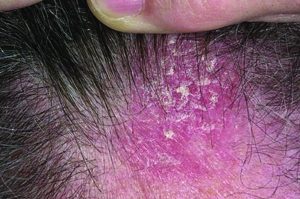

The best example of allergic contact dermatitis is the reaction to the resin in poison ivy plants. The rash consists of red raised bumps in lines or blotches with small clear fluid filled blisters on top. The rash is very itchy, and the skin sometimes weeps fluid. The rash develops 2-14 days after contact with the responsible substances. Other commonly encountered skin allergens that cause dermatitis include nickel in costume jewelry (think of unexplained rashes on ear lobes, necks, and fingers), neomycin, the popular topical antibiotic found in triple-antibiotic Neosporin ointment, as well as fragrances and preservatives found in scores of cosmetics, sunscreens, and prescription medicines.
Probably the most difficult to treat dermatitis is the most common dermatitis known as atopic dermatitis or eczema. This condition affects about 4% of the population at some time in their lives, and is more common and more severe in children. The word atopy refers to an increased sensitivity to the environment including temperature, humidity, textures of clothing, and allergens in foods and in the air. An atopic person is also more likely to have asthma, food sensitivities, and be allergic to penicillin. The atopic tendency is a genetic trait, that is, it is inherited. Any of the features may be inherited singly or together. In other words, the allergies do not cause the eczema; they are separate components of the atopic tendency.
The rash begins as dry itchy skin. In very young children the face and diaper areas are affected first with redness. Later the skin folds of the neck, wrist, elbow and knee creases are attacked with scratch marks, accentuated skin lines, and breaks in the skin leading to infection. In adults, the eczema persists as hand dermatitis aggravated by wet work, soaps, cleaning agents, and food preparation.
Treatment has to be tailored to the individual case based on age, but generally consists of the combination of reduced bathing and exposure to water, use of gentle or super-fatted soaps, liberal use of bland moisturizers, antihistamines for itching and to help sleeping through the night. More severe cases require topical or oral antibiotics, medium to high potency corticosteroid ointments, or internal steroids.
For more information on skin cancer treatment options and other dermatologic concerns, call Dr. Fernandez’s office at 941-906-7546 at Dermatology and Skin Surgical Center. You can also learn more by visiting www.adfdermatology.com
 Southwest Florida's Health and Wellness Magazine Health and Wellness Articles
Southwest Florida's Health and Wellness Magazine Health and Wellness Articles

